Abstract
Using field survey data gathered from seven villages in Youxi County in southern China and a list of famous and ancient trees and groves, this study explored the cultural roots and ecological interpretations of village fengshui forests. The results show as follows: the species of fengshui trees selected by Chinese rural villagers bear a symbolic meaning, including health, longevity, flourishing population, fortune, and wealth. Fengshui belief, clan system, village rules and regulations, fengshui worship tradition, and customs have all played important roles in villagers’ planting and conservation of fengshui forests. It is suggested that the government should recognize the cultural and ecological value of fengshui forests and integrate the local rules and village regulations into the current policy frameworks to improve fengshui (culturally preserved) forests management with favourable polices such as subsidies and conservation strategy. China’s fengshui forests suggest the cultural importance of ecosystem services from forests, and the role of culture in forest conservation.
1. Introduction
Fengshui theory (風水, fēngshuí—also known as geomancy) is a cultural phenomenon with Chinese characteristics [1]. It is a set of empirical principles for people’s favourable selection of villages, residential building, landscape planning, including the knowledge of philosophy, aesthetics, ecology, and environmental art science [2]. Fengshui forests are patches of remnant natural forests or cultivated forest common to rural landscapes in southern and central China [3,4,5] and various countries in East and Southeast Asia [3,6,7]. Ancient Chinese populations conserved and cultivated forests to protect and improve local fengshui, and thereby secure their safety, longevity, prosperity, wealth, and success [8]. Village fengshui forests—i.e., fengshui forests located in and around villages—are the most important type of fengshui forest in China due to their prevalence in the rural landscape and vicinities of human settlements [3,4]. As a result, Chinese people have taken strict measures to protect village fengshui forests. These measures include the use of clan pedigrees (i.e., a book that records the lineage of a family, some of them describing the information on fengshui forests), village rules and regulations, temple rules, and wooden protection tablets [9]. Local people value fengshui forests as forms of cultural heritage and revere them greatly [10].
Fengshui forests are also common in Hong Kong [11], South Korea [12,13], and Okinawa, Japan [14]. Many Chinese scholars have conducted extensive field surveys and reported a high floristic diversity of fengshui forests in these regions [5,15,16,17,18]. Some scholars have stressed that, despite their small size, fengshui forests are important to the preservation of abundant tree species and heterogeneous habitats [15]. Village fengshui forests perform several significant ecological functions—for example, their presence helps reduce wind speed and contributes to water conservation in leeward paddy fields [12]. The make-up of these forests varies—for instance, pine trees dominate the upper part of village fengshui forests in Andong, Korea [19]—and previous studies have considered the composition of fengshui forests to be a product of natural selection [4].
Ancient culture and perceptions have helped local people to nurture and conserve fengshui forests to achieve an ultimate goal of a good life [4,8,9,20], and the forests perform multiple functions within their local ecosystems [21,22,23]. Trees and forests have been planted, cultivated, and protected for similar cultural and religious reasons in various countries, including community forests in Nepal [24] and Guatemala [25], sacred forests in India [26], communally preserved forests in Malaysia [27], and forests protected by churches in Ethiopia [28]. Researchers have shown intense interest in the community characteristics and ecological diversity of village sacred forests [26,29,30], the ecological value of the evolutionary differences between the sacred trees and non-sacred trees [27,31], public cognition and the evaluation of these trees and forests [32], and the opportunities and challenges for their preservation [3,33].
Although many scholarly studies have been conducted to assess the role of fengshui forests in boosting and maintaining biodiversity, relatively little scholarly work has been conducted on the cultural contexts of the planting and preservation of village fengshui forests in China [34]. Fengshui culture, clan systems, and traditional folklore and customs are the basis for the planting and preservation of fengshui forests. This study aims to fill a conceptual gap in the literature by identifying the cultural and ethnographical characteristics of village fengshui forests’ significance, maintenance, and composition in different locales. We conducted a field survey on seven villages in Youxi County in Fujian province in southern China during July and August 2019 and carried out in-depth semi-structured interviews with key informants such as forestry bureau staff and some villagers who are familiar with their village’s fengshui forests. Then, we systematically analysed the cultural roots and ecological functions of village fengshui forests, including fengshui forests around ancestral halls, water tail forests, and fengshui forests in houlongshan mountain behind and upslope from the village. Finally, some recommendations are suggested on how to enhance the planting and conservation of village fengshui forests in China and other countries with similar culturally preserved forests, such as subsidies for planting village fengshui forests.
2. Fengshui Forests as Landscapes and as a Form of Cultural Heritage
Fengshui beliefs provide the basis for the planting and protection of village fengshui forests. Fengshui beliefs can be divided into two influential belief systems: the Compass (理気派 líqìpài, or ‘vital energy regulating’) School from Fujian Province and the Form (形势派 xíngshìpài) School from Jiangxi Province [35]. The Compass School concentrates on the arrangement of spaces and artefacts within spaces. It is an intricate divinatory philosophy of China that needs to use a compass and the concept of orientation [36]. In contrast, the Form School focuses on issues concerning the selection of a site and its surrounding landscape, and emphasizes that a good site requires hills to provide protection from the wind (Feng), and for a good water (Shui) supply without flooding [2]. The latter was introduced to Fujian Province by Han (汉, Hàn) migrants from Jiangxi Province, specifically by the Hakka people—a subgroup of the Han. The Hakka firmly embraced fengshui beliefs and culture, and their introduction of the form and configuration schools of fengshui had a significant influence on the course of modern Chinese history.
Fengshui believers see environments comprising ‘good land contour, rich water, abundant trees, and bushes’ as an ideal fengshui environment. The neo-Confucian master Cheng Yi (程颐, Chéng Yí) concluded that ‘beauty earth must have the characteristics of lustrous earth colour and luxuriant vegetation’. This last tenet—luxuriant vegetation—is the basis for village fengshui forests’ cultivation and maintenance.
Fengshui believers also postulate that the ideal living environment can resist wind, conserve water, and accumulate qi (気qì, so-called “air”)’ [37]. Qi was originally conceived as a flowing and amorphous material existence, which then was sublimated into a metaphysical philosophy category, thereby passing from specific things to the general. It is considered the source of all things in fengshui philosophy and is also considered the determinant of good or ill fortune [38]. Qi is considered to disperse when encountering wind and to accumulate when encountering water; therefore, ancient Chinese selected village sites based on the landscape’s capability to calm wind and attract water to gather auspicious qi. Villagers were also convinced that fengshui forests could help block out external, evil qi and thus guarantee their safety [39].
Ancient Chinese populations also believed that the spirits of their ancestors were buried in fengshui forests, and that these spirits blessed all villagers with happiness and peace of mind. They also believed that the forests around villages’ ancestral halls are just like clothes and armour and have a similar protective function. Thus, it is prohibited to intrude in, disturb, or destroy these forests. In addition, ancient Chinese populations considered the luxuriant trees of village fengshui forests to symbolise the continuity of life over many generations. Such forests were metaphors for the rise and fall of a clan and were closely related to the destiny of a given village.
3. Study Sites and Data Collection
3.1. Study Sites
Fujian Province is located in the south of China (23°33′–28°20′ N latitude and 115°50′–120°40′ E longitude). Its geography is largely mountainous, but also has hills, plains, and coastal areas. About one-third of Fujian’s 39 million inhabitants live in rural areas. The strong influence of fengshui culture in this area can be demonstrated by the fact that most villages feature two fengshui forests on average and that 80.4% of the fengshui forests have not been damaged [40]. There are more village fengshui forests in the province’s mountainous areas than in its plains and coastal areas, and these are mainly located near a villages’ entrances, ancestral halls, and temples.
Youxi County is located in the centre of Fujian Province (25°50′–26°26′ N latitude and 117°48′–118°39′ E longitude). The county covers 3463 km2 and contains 10 towns and 5 townships. In this study, seven villages—one in each town—were selected for field surveys. Among them, Guifeng and Lingtou Villages are heavily influenced by eastern Fujian culture, Houping Village is influenced by northern Fujian culture, Zhongxian Village is influenced by southern Fujian culture, Kengtou and Dongshang Villages are influenced by Hakka culture, and Gaoshan Village is influenced by the local culture. This geographical distribution enabled the evaluation of the potential influences of different cultures on the planting and protection of fengshui forests in Youxi County. The geographical distribution of the sample villages is shown in Figure 1, and details on the villages are given in Table 1.
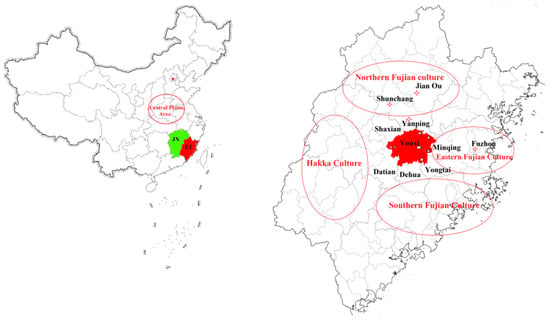
Figure 1.
Distribution of the seven villages. Note: △, ○, ◇, □, ☆, ¤ and ◎ represent Guifeng, Zhongxian, Houping, Gaoshan, Kengtou, Dongshang, and Lingtou villages, respectively; ‘FJ’ represents Fujian Province, and ‘JX’ represents Jiangxi Province.

Table 1.
Types of fengshui forests at the survey sites.
As shown in Table 1, we focused on three types of village fengshui forests, including fengshui forests around an ancestral hall (祠堂, cítáng) and upon Hulong mountain (后龙山/後龍山, Hòulóngshān), and water tail forests (水尾林, shuíwěilín). Among them, the ancestral hall is a hall for villagers to worship their ancestors; the Houlong mountain is typically located behind the village, or is a mountain near but higher than the house-level/the residential area (see Appendix A for details); and the water tail is where the stream flows out of the village (see Appendix B for details).
Youxi County contains mostly mountainous terrain. The Neo-Confucian master Zhu Xi (1130–1200) was a native of Youxi County, so it is possible that his teachings had a significant impact on the planting and preservation of fengshui forests in Youxi County. For about 30% of its history, the county was governed by a higher-level government in Fuzhou; this promoted the absorption of the eastern Fujian culture in Fuzhou. Most descendants of Han migrants moved to Youxi County along the Minjiang River and roads built by the government. This migratory pattern indicates that the fengshui culture and other traditional customs of Youxi County might have been influenced by cultures originating within the central plains. Indeed, Fujian’s central location enabled the Youxi culture intercontact with different cultures and traditions, including Hakka peoples’ own version of fengshui philosophy and culture from Shaxian County. Thus, Youxi County within Fujian Province is a suitable study site because it contains a rich history of cultural fusion and interaction between the indigenous culture of the county and different sub-cultures of the province.
3.2. Data Collection
We conducted the field surveys in July and August 2019. The first survey was conducted on 18–19 July 2019. This survey sought to understand the overall situation of fengshui forests in Youxi County. Interviewees (n = 4) for this first survey were county forestry bureau staff who were familiar with the historical/current situation of fengshui forests, including current policies for their development. We also obtained a list of famous and ancient trees (or groves) compiled by the county forestry bureau’s census of ancient and famous trees. This census was conducted between March 2015 and December 2016 and covered 15 townships and over 250 administrative villages.
The second survey was conducted on 1–3 August 2019. In this survey, we selected at least a village from the each of four cultural blending areas to investigate whether there were differences in the planting and preservation of fengshui forests in different areas. Then, we carried out semi-structured interviews with fengshui Master (風水先生, fēngshuíxiānshēng, n = 7), village cadres (n = 7), clan chiefs (n = 7), villagers (n = 7) familiar with their village’s history or with fengshui forests from each village, and with the township forestry extension station staff (n = 7) from each town. These key informants were usually folk story tellers and analysts of nature and historical events of fengshui forests. Each interview lasted 30–60 min and was followed by a follow-up interview via telephone. The interviews were conducted in a local language and notes were taken in Mandarin Chinese. Moreover, information related to the village’s genealogy and rules was also collected.
3.3. Data Analysis
The data collected are qualitative data except for the list of famous and ancient trees (or groves). The qualitative data included information regarding the origin, purpose, size, location, tree species composition, type, and historical significance of fengshui forests. They also included information regarding the measures taken to protect fengshui forests, celebrity anecdotes, and features of village life (including rules, customs, and tree worship rites). We also collected various pieces of information regarding the development, history, terrain, climate, geographical location, surrounding environment, clan consciousness, customs and habits, and architectural elements of village design which are related to or inspired by fengshui. We treated these different bodies of original data into a format to explore the research questions posed and arrived at specific conclusions, and the treatment measures involved comparison, analogy, induction and summarization.
4. Results
4.1. Major Fengshui Tree Species and Cultural Connotations
The list of famous and ancient trees and groves by the Forestry Bureau has 1333 trees documented in Youxi County: 412 trees stand alone and are scattered throughout the area, and 921 are concentrated in 58 clusters. The oldest one is said to be 1562 years old. These trees are typically located in the village fengshui forests along rivers, at village entrances, and around ancestral halls, houses, and tombs. The fengshui forests in Lingtou Village cover an area of over 20 hectares and have been preserved for over 800 years.
In Youxi County, the famous and ancient trees include 24 species (see Table 2). According to the number of each tree species, the 10 most important species are Cinnamomum camphora, Cryptomeria fortune, Taxus chinensis, Ginkgo biloba, Phoebe bournei, Keteleeria fortunei, Ormosia henryi, Ficus microcarpa, Podocarpus macrophyllus, and Altingia gracilipes. Through our interviews, we learned that each of these species carries different cultural connotations. For instance, of the 10 species listed above, eight (except Ormosia henryi and Altingia gracilipes) are considered to be endowed with longevity and health. Cinnamomum camphora is widely planted because it is considered to bring peace, prosperity, talent, good luck, and protection against evil. Cryptomeria fortune and Taxus chinensis symbolise harmony, happiness, and nobility. Gingko biloba and Keteleeria fortunei symbolise perpetual prosperity and fertility for those who tread in their ancestors’ footsteps. Phoebe bournei expresses the idea that more children mean more blessings. Ormosia henryi symbolises power, status, and wealth. Ficus microcarpa symbolises peace and auspiciousness. The branches of Ficus microcarpa are used on special occasions, including weddings, housewarming parties, and funerals. Podocarpus macrophyllus symbolises financial prosperity. Altingia gracilipes has attributes which preserve soil and conserve water. In short, the species composition of these forests is not accidental—it is intentional and driven by cultural beliefs.

Table 2.
Common ancient trees in Youxi County (unit = a plant or a grove).
4.2. The Roles of Fengshui Culture and Ecological Thoughts
The investigated villages are all surrounded by mountains in Appendix A (Figure A1) and Appendix B (Figure A3, Figure A4 and Figure A5), and the villagers’ ancestors have planted and protected forests on the mountains’ slopes. Based on the view of the Form school of fengshui, people in the surveyed villages sought and preserved the “dragon vein (Dragon Mountain)” to maintain good fengshui and turned this quest into a purposeful act of preserving mountain vegetation and forests. The so-called “dragon vein” is the mountain range and ridge that “stores wind, conserves water, and accumulates qi” [41]. In other words, an ideally orientated village should have winding mountains at its back (the Houlong mountain) and other mountains on its left (the azure Dragon, Qinglong, 青龙/青龍) and right sides (the White Tiger, Baihu, 白虎); and be located in the basin surrounded by low hills. In addition, mountains or hills should converge where rivers and streams flow out of the village [3]. The villagers portrayed the artificial or natural forests upon the dragon vein as the dragon’s hair and very important fengshui forests, and thus did not allow them to be destroyed.
The ancestors preserved the “dragon hair” (fengshui forests) for protecting fengshui though blocking the external evil qi and gathering the good qi, as well as for the ecosystem functions delivered by fengshui forests, including enhancing water storage, filtering water, mitigating flooding, and wind damage [3,42]. Moreover, although the interviewees stressed that they and their ancestors planted or preserved water tail forests for the purpose of resisting evil qi, they seemingly attach greater importance to the ecological functions of water tail forests, such as the reduction in the wind and preventing roads and woodlands near rivers being washed away. When storms and other natural disasters hit, forests stand strong. In short, water tail forests contribute to a healthier and more comfortable living environment, and effectively guarantee agricultural production. The discussion above reflects the harmonious symbiosis between forested landscapes and the environment, and the ideal of “unity of man and universe” [43,44].
4.3. Three Types of Water Tail Fengshui Forests
There are three types of water tail fengshui forests. The first type is a simple fengshui conglomeration. Here, the water tail (Figure 2) is located near a village’s entrance and exit to protect it from evil qi. As Table 1 shows, six of the seven surveyed villages have water tail forests.
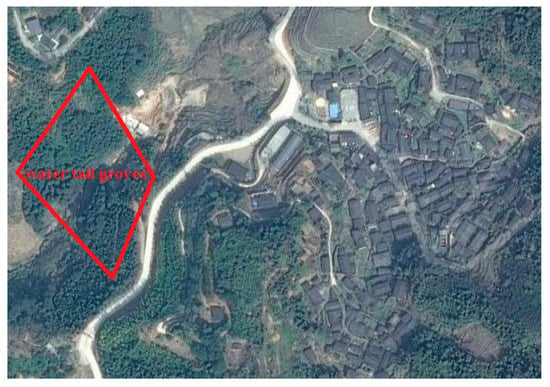
Figure 2.
Water tail forests in Guifeng Village.
The second type of water tail fengshui forest combines fengshui forests, a corridor bridge, and/or a temple. The Hakka people deeply believe in that water must flow into and out of a village through a broad, heavenly entrance and a narrow earthen exit. In Dongshang Village, for example (Figure 3), where the Hakka culture is blended with the local culture of Youxi County, a fengshui forest and corridor bridge at the water tail creates a narrow earth exit, thus metaphorically preventing money from leaving the village too quickly. There is a canal on the far side of the bridge so that people can see the stream’s flow—this is the broad, heavenly entrance which symbolises the inflow of fortune from all directions.

Figure 3.
Corridor bridge in Dongshang Village.
The third type of water tail fengshui forest combines forests with temples and other sites of polytheistic worship. In Figure 4, we see that not all sites are housed in temples—they sometimes feature memorial tablets in nature (usually under or near a famous or ancient tree). Here, the inhabitants of Lingtou Village placed open-air memorial tablets under the ancient Cryptomeria fortunei and built a temple for their earth god there. Figure 5 shows a more conventional site of worship—a temple in Kengtou Village, which was built next to a fengshui forest.
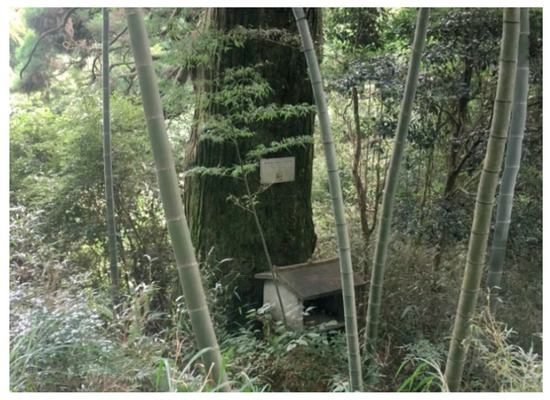
Figure 4.
Open-air memorial tablet in Lingtou Village.
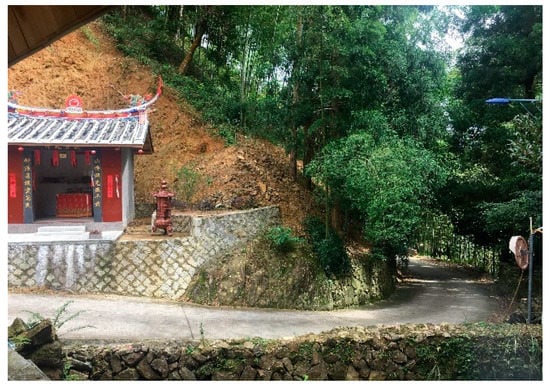
Figure 5.
Temple of the earth god in Kengtou Village.
The forms of fengshui forests mentioned above reflect the psychological, spiritual, and community needs of villagers. The integration of culture and ecological thoughts here means that, in some places, villages have developed their own distinctive style of fengshui forests.
4.4. Fengshui Forests around Ancestral Halls
Fengshui forests are often located around ancestral halls (Table 1). These halls are temples dedicated to deified ancestors and are closely linked to Chinese traditions of filial piety. Almost every village in Youxi County has surrounded its ancestral hall with a fengshui forest. Villagers often plant trees on elevated terrain behind the ancestral hall or plant fengshui forests of their ancestral halls (Figure A2). Reverence for these halls and the land they stand on is not only guided by the Confucian filial piety, but by the desire to create an untouched, dense fengshui forest (thus boosting its various protective and predictive powers).
Villagers have, historically, selected the sites of these halls with the village’s unique terrain and topographic features in mind. Often, these halls are endowed with special symbolic significance by their actual shape, which sometimes resembles the form of a creature. For instance, the founders of Guifeng Village fused their ancestral hall with the local terrain to make the shape of a phoenix holding a book in its beak, where the ancestral hall forms the head of the phoenix and fengshui forests represent its crest. In this way, the architecture of the hall and its cultivated surroundings symbolise the villagers’ commitment to education and historical desire to do well in imperial examinations. The shape of the fengshui forests behind the ancestral hall in Zhongxian Village resembles a chicken hatching a golden egg—a symbol of fertility and wealth (Figure 6a). Likewise, villagers in Lingtou Village see the environment surrounding their ancestral hall as a swan hatching eggs—a symbol of their descendants’ fertility (Figure 6b).
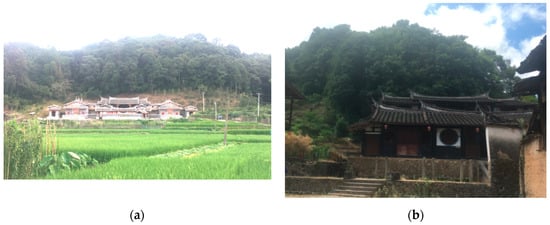
Figure 6.
Fengshui forests around ancestral halls in (a) Zhongxian Village on the left and (b) Guifeng Village on the right.
People in the Guifeng, Zhongxian and Lingtou villages believe that the planting and preservation of fengshui groves around their ancestral hall contributes to the achievements of their fellow villagers. These beliefs appear to be grounded in a sufficient base of knowledge. Based on the data we collected, 107 people from Guifeng Village (population: 1268) have been admitted to college since 1977; the Chi (迟, Chí) family in Zhongxian Village has had more than 4800 descendants in the past 650 years (300 of whom have attained bachelor’s degrees); and the Wu (吴, Wú) family which founded Lingtou Village 800 years ago has some 10,000 descendants.
4.5. Experience and Practice of Protecting Fengshui Forests
Ancient Chinese villagers’ beliefs and practical experience led them to maintain fengshui forests by a system of punishments embedded within traditional customs, clan pedigrees, village rules and regulations, and temple rules [19]. Each of the sample villages has its own regulations and agreements for the protection of fengshui forests. For instance, in Zhongxian Village, villagers set up a wood protection tablet next to a fengshui tree; in Lingtou Village, seven commandments regarding trees are listed in the clan pedigree. The punishments include performing animal sacrifices, giving financial offerings to gods, hosting village banquets, fining those who intrude in fengshui forests, having intruders parade through the streets wearing a sign admitting to their sins, and so on. Some tales of punishment are rather gruesome. For instance, bandits who cut down fengshui forests/trees in Kengtou Village had excrement poured down on them. In Dongshang Village, villagers are prohibited from collecting timber from fallen fengshui trees (even if they had died from natural causes). Some of these protocols are recent rather than ancient, given that fengshui forests across China were seriously damaged during the Great Steelmaking Period (1957–1958) and the Cultural Revolution (1966–1976) of the twentieth century [45].
4.6. Government Support for Planting and Preserving Fengshui Forests
The planting of fengshui trees was an official act in ancient China and the implicit fengshui concept was acknowledged and practiced by officials and intellectuals. Before the Tang Dynasty, fengshui masters mainly served the imperial family, literati, scholars, and the upper classes in the Central Plains Area (the administrative centre of ancient China, as shown in Figure 1). In recent years, forestry officials in Jiangxi and Fujian have begun to view fengshui forests as unique cultural and ecological resources which represent the Chinese people’s distinctive socio-ecological heritage. These officials have emphasised the importance of preserving village fengshui forests for these reasons. There have been a few practical efforts made in this regard. For instance, Sanming City (the direct higher-level government of Youxi County) selected the most beautiful fengshui trees and forests in the countryside and offered subsidies for landscaping. In Jiangxi Province, Fujian Province and Anhui Province, local authorities have officially designated some fengshui forests as “small protected areas (保護小區, báo hù xiáo qū)” or a “community-based nature reserve” [8]. Since the early 1990s, Wuyuan county within Jiangxi Province enacted a legislation to provide subsidies for villages managing a “community-based nature reserve” or “fengshui forest” [46]. Recently, more funds have been made available to the villages to plant and manage village fengshui forests, such as funds for beautiful countryside construction, new rural construction, and other related projects. For instance, the planting of fengshui trees around the ancestral hall of the Chi family in Zhongxian Village (as shown in the upper right corner of Figure 6a) was subsidized by the first one. The planting of fengshui trees was an official act of governance in ancient China and has the potential to gain considerable momentum today, thus contributing to the preservation of China’s unique heritage.
5. Conclusions and Recommendation
This study highlights the cultural and ecological underpinnings of the creation, cultivation, and maintenance of village fengshui forests in southern China. Fengshui trees and forests are usually located in culturally and ecologically significant places in rural villages—near ancestral halls, village entrances and exits, waterways, and tombs—and perform a variety of functions. It is found that the dominant species of tree in village fengshui forests in Youxi County are Cinnamomum camphora, Cryptomeria fortune, and Taxus chinensis among others for their natural beauty, ecological functions, and cultural symbolism alike, rather than economic utility [4]. The accordance between the fengshui culture and ecological protection concept is the very cultural foundation for planting and preserving village fengshui forests, and traditional means of clan pedigrees, village rules and regulations, and temple rules are proved to be effective to protect these forests. The findings also show variance in how water tail forests are planted and protected across cultural and regional lines. Planting and preserving village fengshui forests have been supported by both ancient and modern Chinese governments. This study contributes to the literature by filling in a knowledge gap regarding the cultural origin and local people’s understanding of village fengshui forests and their significance to the ecological and cultural landscapes of rural China. This also demonstrates how fengshui is deeply rooted in local understandings of nature and climate and how cultural beliefs such as fengshui can serve as effective conservation instruments for small-scale forests.
Village fengshui forests have been protected by village people in China for a long time and have been integrated into Chinese culture. It can be expected that these forests will be likely to persist. To maintain and improve village’s fengshui and ecological environment, the Chinese rural villagers have the consciousness and willingness to plant and preserve the village fengshui forests. Under the strict punishments of informal rules, fengshui forests in rural China have been well protected. Moreover, according to the interviewees’ feedback, with the increase in villagers’ income, village fengshui forests will likely be better protected and managed in the future. Hence, Chinese policy makers need to recognize the merits of local customs, as well as encourage and integrate informal rules into current natural protection policy frameworks to improve (fengshui) forests management [18,29]. Then, the practice of Fujian, Jiangxi, Anhui, and other provinces can be disseminated. That is, the local governments should highlight fengshui forests’ landscape value and ecological value, through a/some specific action or legislation, such as selecting the most beautiful fengshui forests/trees and designating some qualified fengshui forests as “small protected areas”. Moreover, the local governments should bring village fengshui forests into rural landscape planning, land use planning or other specific planning. The above measures can help transform fengshui forests as “superstition colour” to more as cultural and ecological heritage and value, which can provide further justification for institutional support and the social atmosphere in villages for applying and using relevant funds to plant and preserve fengshui forests. These funds should be allowed to plant fengshui forests in a new site or sustain existing forests.
Sacred forests and other forests like fengshui forests in other countries and regions still experience reduction in size today [31,47]. To reverse this spiral of decline, it is recommended that fengshui theories and their traditional custodians should be a complementary strategy within a supportive regulatory framework and not undermined by governmental and non-governmental organizations. It should be encouraged that governments should use cultural education programmes to guide the planting and preservation of these ecologically and culturally rich and significant forests, which can help to ensure continuity in the traditional tree-management and protection regime.
Author Contributions
Conceptualization, Y.D. and Y.Z.; methodology, Y.D. and Y.Z.; formal analysis, W.L.; investigation, Y.D., J.C. and W.L.; resources, J.C. and W.L.; data curation, J.C. and W.L.; writing—original draft preparation, J.C., W.L. and B.C.; writing—review and editing, B.C., Y.D. and Y.Z.; visualization, Y.D. and Y.Z.; supervision, B.C.; project administration, J.C.; funding acquisition, Y.D. All authors have read and agreed to the published version of the manuscript.
Funding
This research was funded by the National Natural Science Foundation of China as Grant #: CRDPJ 71973027, and The Collective Forestry Reform and Development Research Center as Grant #: K80RAQ04A.
Conflicts of Interest
The authors declare no conflict of interest. The funders had no role in the design of the study; in the collection, analyses, or interpretation of data; in the writing of the manuscript, or in the decision to publish the results.
Appendix A. Three Types of Village Fengshui Forests
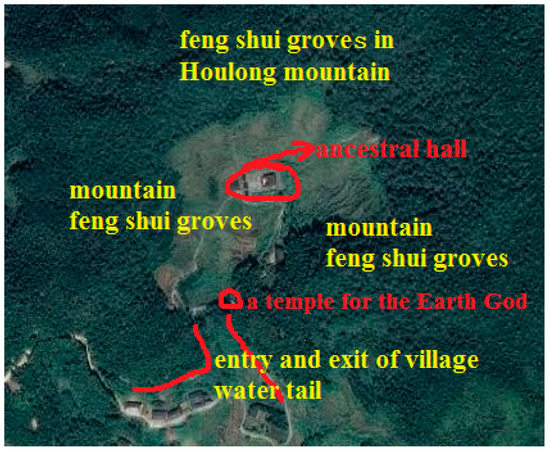
Figure A1.
Geographical features of Lingtou village. Note: village houses surround the ancestral hall in ancient times. Vacant land in the figure is farmland.
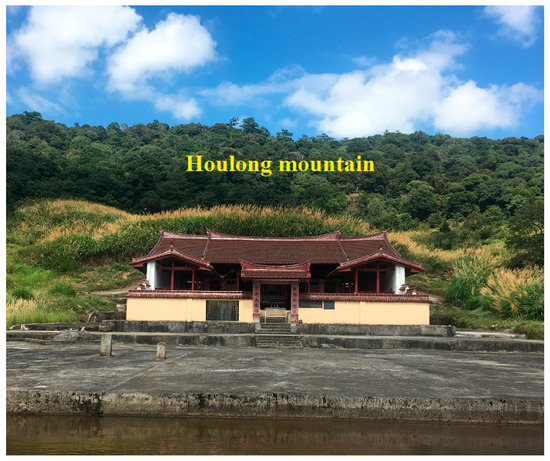
Figure A2.
Fengshui forests around the ancestral hall of Lingtou Village.
Appendix B. Geographical Features of Dongshang, Gaoshan, and Kengtou Villages

Figure A3.
Geographical features of Dongshang Village.
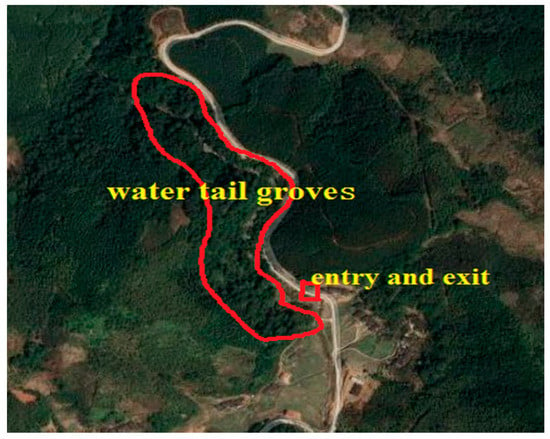
Figure A4.
Geographical features of Gaoshan Village.
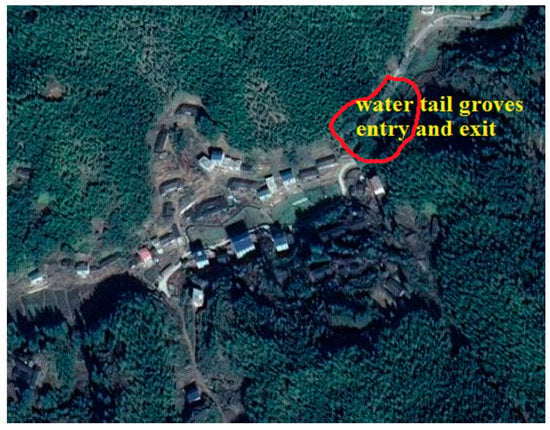
Figure A5.
Geographical features of Kengtou Village.
References
- Li, H.M. Analysis of the application of traditional “feng shui” theory in modern home space. Stud. Sociol. Sci. 2014, 5, 105–109. [Google Scholar]
- Juan, Y.K.; Chien, S.F.; Li, Y.J. Customer focused system for pre-sale housing customisation using case-based reasoning and feng shui theory. Indoor Built Environ. 2010, 19, 453–464. [Google Scholar] [CrossRef]
- Chen, B.X.; Coggins, C.; Minor, J.; Zhang, Y.X. Fengshui forests and village landscapes in China: Geographic extent, socioecological significance, and conservation prospects. Urban. For. Urban. Green. 2018, 31, 79–92. [Google Scholar] [CrossRef]
- Coggins, C.; Chevrier, J.; Dwyer, M.; Longway, L.; Li, Z. Village fengshui forests of southern China: Culture, history, and conservation status. ASIA Netw. Exch. 2012, 19, 52–67. [Google Scholar] [CrossRef]
- Ma, L.; Huang, M.; Shen, M.; Cao, H.; Wang, Z. Species diversity and community structure in forest fragments of Guangzhou, South China. J. Trop. For. Sci. 2015, 27, 148–157. [Google Scholar]
- Chen, B.X.; Nakama, Y. Traditional Rural Landscapes in Island Topography in East. Asia; Nova Science Publishers, Inc.: New York, NY, USA, 2012. [Google Scholar]
- Chun, Y.W.; Tak, K.I. Songgye, a traditional knowledge system for sustainable forest management in Choson Dynasty of Korea. For. Ecol. Manag. 2009, 257, 2022–2026. [Google Scholar] [CrossRef]
- Yuan, J.; Liu, J. Fengshui forest management by the Buyi ethnic minority in China. For. Ecol. Manag. 2009, 257, 2002–2009. [Google Scholar] [CrossRef]
- Guan, C. Fengshui Landscapes: The Culture of Fengshui Forests; Southeastern University Publishers: Nanjing, China, 2012. [Google Scholar]
- Marafa, L.M. Integrating natural and cultural heritage: The advantage of feng shui landscape resources. Int. J. Herit. Stud. 2013, 9, 307–323. [Google Scholar] [CrossRef]
- Zhuang, X.; Corlett, R.T. The conservation status of Hong Kong’s tree flora. Chin. Biodivers. 1996, 4, 36–42. [Google Scholar]
- Koh, I.; Kim, S.; Lee, D. Effects of bibosoop plantation on wind speed, humidity, and evaporation in a traditional agricultural landscape of Korea: Field measurements and modeling. Agric. Ecosyst. Environ. 2010, 135, 294–303. [Google Scholar] [CrossRef]
- Whang, B.; Lee, M. Landscape ecology planning principles in Korean Feng-Shui, Bi-bo woodlands and ponds. Landsc. Ecol. Eng. 2006, 2, 147–162. [Google Scholar] [CrossRef]
- Chen, B.X.; Nakama, Y. A fengshui landscape and tree planting with explanation based on fengshui diaries: A case study of Mainland Okinawa, Japan. World Views Environ. Cult. Relig. 2011, 15, 168–184. [Google Scholar]
- Hu, L.; Li, Z.; Liao, W.B.; Fan, Q. Values of village fengshui forest patches in biodiversity conservation in the Pearl River Delta, China. Biodivers. Conserv. 2011, 144, 1553–1559. [Google Scholar] [CrossRef]
- Tang, C.Q.; Yang, Y.; Ohsawa, M.; Momohara, A.; Mu, J.Z.; Robertson, K. Survival of a tertiary relict species, Liriodendron chinense (Magnoliaceae), in southern China, with special reference to village fengshui forests. Am. J. Bot. 2013, 100, 2112–2119. [Google Scholar] [CrossRef] [PubMed]
- Pang, C.C.; Ma, X.; Hung, T.H.; Hau, B.C.H. Early ecological succession on landslide trails, Hong Kong, China. Ecoscience 2018, 25, 1–11. [Google Scholar] [CrossRef]
- Huang, L.; Tian, L.; Zhou, L.; Jin, C.; Yang, Y. Local cultural beliefs and practices promote conservation of large old trees in an ethnic minority region in southwestern china. Urban. For. Urban. Green 2020, 49, 126584. [Google Scholar] [CrossRef]
- Kim, H. A study on the growth and management status of Mansongjung forest in Hahoe, Andong. J. Korean Nat. 2011, 4, 161–171. [Google Scholar] [CrossRef][Green Version]
- Liu, D.; He, X.; Jiang, J. Status quo of culture and inheritance about Fengshui woods in Guilin Houlong Mountain. J. Beijing For. Univ. 2013, 12, 23–27. [Google Scholar]
- Coggins, C.; Minor, J.; Chen, B.; Zhang, Y. China’s community fengshui forests—spiritual ecology and nature conservation. In Cultural and Spiritual Significance of Nature in Protected Areas; Verschuuren, B., Brown, S., Eds.; Routledge: Abingdon, UK, 2018; pp. 225–237. [Google Scholar]
- Guan, C. Study on knowledge and practice on function of conserving water and soil of forests in ancient China. Sci. Soil Water Conserv. 2004, 2, 105–110. [Google Scholar]
- Han, M. The Research of Geomancy Forests around Villages on sand in Dongshan Island. Fuzhou. Master’s Thesis, Fujian Agriculture and Forestry University, Fuzhou, China,, 2011. [Google Scholar]
- Birch, J.C.; Thapa, I.; Balmford, A.; Bradbury, R.B.; Brown, C.; Butchart, S.H.M.; Gurung, H.; Hughes, F.M.R.; Mulligan, M.; Pandeya, B.; et al. What benefits do community forests provide, and to whom? A rapid assessment of ecosystem services from a Himalayan forest. Nepal. Ecosyst. Serv. 2014, 8, 118–127. [Google Scholar] [CrossRef]
- Taylor, P.L. Conservation, community, and culture? new organizational challenges of community forest concessions in the maya biosphere reserve of Guatemala. J. Rural Stud. 2010, 26, 173–184. [Google Scholar] [CrossRef]
- Bhagwat, S.A.; Nogué, S.; Willis, K.J. Cultural drivers of reforestation in tropical forest groves of the western ghats of India. For. Ecol. Manag. 2014, 329, 393–400. [Google Scholar] [CrossRef]
- Takeuchi, Y.; Soda, R.; Diway, B.; Kuda, T.; Nakagawa, M.; Nagamasu, H.; Nakashizuka, T.; Zang, R.G. Biodiversity conservation values of fragmented communally reserved forests, managed by indigenous people, in a human-modified landscape in Borneo. PLoS ONE 2017, 12, e0187273. [Google Scholar] [CrossRef]
- Scull, P.; Cardelús, C.; Klepeis, P.; Woods, C.L.; Frankl, A.; Nyssen, J. The resilience of Ethiopian church forests: Interpreting aerial photographs, 1938-2015. Land Degrad. Dev. 2016, 28, 450–458. [Google Scholar] [CrossRef]
- Gao, H.; Ouyang, Z.; Chen, S.; Koppen, C.S.A. Role of culturally protected forests in biodiversity conservation in Southeast China. Biodivers. Conserv. 2013, 22, 531–544. [Google Scholar] [CrossRef]
- Cardelús, C.L.; Scull, P.; Hair, J.; Baimas-George, M.; Lowman, M.; Eshete, A. A preliminary assessment of Ethiopian sacred grove status at the landscape and ecosystem scales. Diversity 2013, 5, 320–334. [Google Scholar] [CrossRef]
- Daye, D.D.; Healey, J.R. Impacts of land-use change on sacred forests at the landscape scale. Glob. Ecol. Conserv. 2015, 3, 349–358. [Google Scholar] [CrossRef]
- Osuri, A.M.; Madhusudan, M.D.; Kumar, V.S.; Chengappa, S.K.; Kushalappa, C.G.; Sankaran, M. Spatio-temporal variation in forest cover and biomass across sacred groves in a human-modified landscape of India’s Western Ghats. Biodivers. Conserv. 2014, 178, 193–199. [Google Scholar] [CrossRef]
- Aerts, R.; Van Overtveld, K.; November, E.; Wassie, A.; Abiyu, A.; Demissew, S.; Daye, D.D.; Giday, K.; Haile, M.; TewoldeBerhan, S.; et al. Conservation of the Ethiopian church forests: Threats, opportunities and implications for their management. Sci. Total Environ. 2016, 4, 404–414. [Google Scholar] [CrossRef]
- Dai, X. The progress of the geomantic forests in China. Chin. Agric. Sci. Bull. 2011, 27, 1–4. [Google Scholar]
- Mak, M.Y.; Ng, S.T. The art and science of feng shui—A study on architects’ perception. Build. Environ. 2005, 40, 427–434. [Google Scholar] [CrossRef]
- Daneshvar, M.R.M.; Khosravi, S.; Rezayi, S. Ecological evaluation of landscape using feng-shui theory at shandiz urban region, ne Iran. Int. J. Environ. Prot. Policy 2014, 1, 32–37. [Google Scholar] [CrossRef][Green Version]
- Wu, W.Y.; Yau, O.H.M.; Lu, H.Y. Feng shui principles in residential housing selection. Psychol. Mark. 2012, 29, 502–518. [Google Scholar] [CrossRef]
- Hwangbo, A. A new millennium and Feng Shui. J. Archit. 1999, 4, 191–198. [Google Scholar] [CrossRef]
- Lin, C. The impacts of Feng Shui factors on the price of real estate. Land Issues Res. Q. 2007, 6, 45–52. [Google Scholar]
- Xu, F.; Qiu, E.F.; Wang, C. Tree species structure of Fengshui forest in Fujian Province. J. Jiangxi Agric. Univ. 2012, 34, 99–106. [Google Scholar]
- Field, S.L. In Search of Dragons: The Folk Ecology of Fengshui. In Daoism and Ecology: Ways Within a Cosmic Landscape; Girardot, N.J., Miller, J., Xiaogan, L., Eds.; Harvard University Press: Cambridge, MA, USA, 2001. [Google Scholar]
- Li, S.; Ye, Y.; Wang, F.; Zeng, F.; Xu, Z. Analyses on species composition and arealtype of Fengshui woods in Guangzhou City. J. Plant. Resour. Environ. 2013, 22, 102–109. [Google Scholar]
- Tang, Y.J. The contemporary significance of Confucianism. Front. Philos. China 2008, 3, 477–501. [Google Scholar] [CrossRef]
- Theatre, E.K.; Chow, C.S. The geographer and the fengshui practitioner: So close and yet so far apart? Aust. Geogr. 2002, 31, 309–332. [Google Scholar] [CrossRef]
- Cao, L.; Wen, M.; Liu, S.; Ou, X. Investigation and protection of rural Fengshui forest in the Hakka Area: Case study in the Longcun Township, Meizhou City. Subtrop. Soil Water Conserv. 2015, 27, 43. [Google Scholar]
- Coggins, C. Jiangxi village fengshui forests. Forest Hum. 2014, 294, 40–49. [Google Scholar]
- Woods, C.L.; Cardelús, C.L.; Scull, P.; Wassie, A.; Klepeis, P. Stone walls and sacred forest conservation in ethiopia. Biodivers. Conserv. 2016, 26, 209–221. [Google Scholar]
Publisher’s Note: MDPI stays neutral with regard to jurisdictional claims in published maps and institutional affiliations. |
© 2020 by the authors. Licensee MDPI, Basel, Switzerland. This article is an open access article distributed under the terms and conditions of the Creative Commons Attribution (CC BY) license (http://creativecommons.org/licenses/by/4.0/).